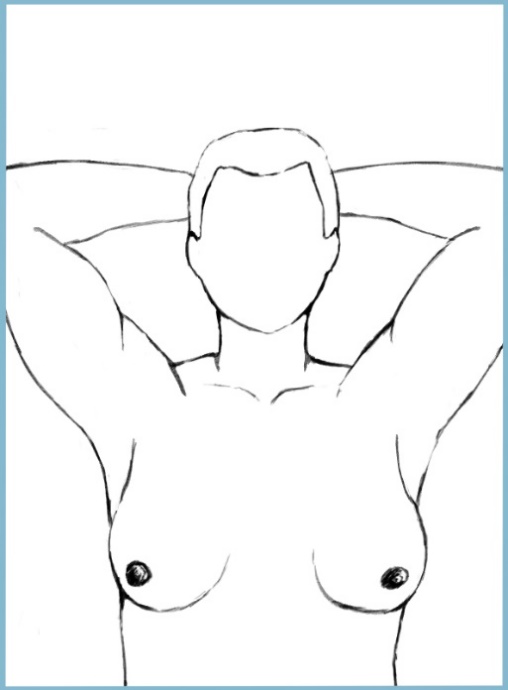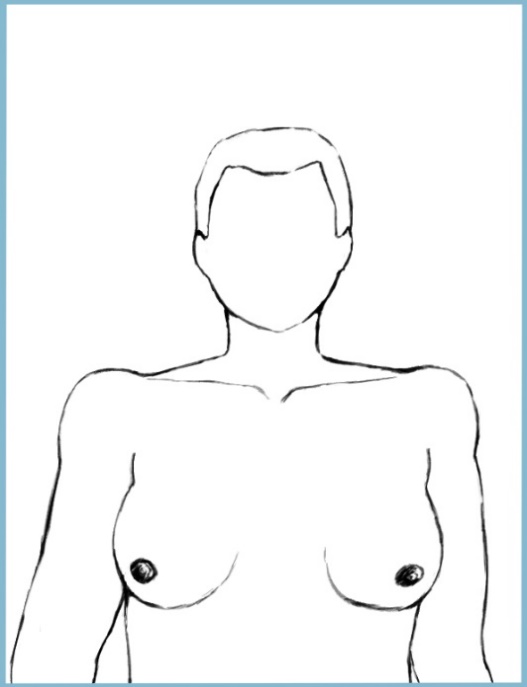Breast self-examination
The aim of this leaflet is to provide information on the importance of breast self-examination and the techniques used.
Breast cancer is the most common malignant tumour in women in Estonia. It does not usually cause any symptoms or pain at the early stages of the disease.
In order to detect any changes as early as possible, women are advised to check their own breasts regularly from the age of 20. If detected early, breast cancer is treatable.
For breast self-examination, you need to look at your breasts and feel them with your fingers. Women at high risk for breast cancer should definitely examine their breasts.
Women at high risk for breast cancer are those who:
-
have had breast cancer;
-
have a benign change in their mammary gland that is considered to increase the risk of breast cancer;
-
have a close relative under the age of 50 diagnosed with breast cancer;
-
have a close relative on their mother's or father's side diagnosed with a gene mutation that predisposes them to breast or ovarian cancer;
-
have one or more relatives on their mother's or father's side diagnosed with breast cancer;
-
have one or more relatives on their mother's or father's side diagnosed with ovarian cancer;
-
have male relatives diagnosed with breast cancer.
Be sure to see your family doctor or a specialist at a breast health clinic if, during a breast self-examination, you notice:
-
a change in the shape or size of the breast, or a change in its skin colour;
-
knots, seals or ‘lumps’ in the chest or armpit;
-
a change in the nipple, for example a retracted nipple;
-
discharge from the nipple;
-
breast redness, ulceration or orange-peel skin on the breast;
-
enlarged lymph nodes in the armpit.
How to check your own breasts?
Breast self-examination techniques are simple, you just need to look at and touch your breasts.
Check your breasts once a month on a fixed day. The best time for self-examination is after menstruation, when breast tissue is softer, and the breasts are easier to feel.
Undress, look at your breasts in front of a mirror, first with your hands by your side and then with your hands on your head.


Here’s what you should pay attention to:
-
whether your breasts are the usual shape and size
-
whether the skin is smooth and even, whether there are any changes in colour
-
whether the nipples seem normal and move up as you raise your arm
The breasts will be easier to feel when washed. Knots and lumps are easily felt under a soapy hand.
-

-
Starting from the left breast, first place your left hand at the back of your head and gently press on the breast in a circular motion with your right hand, using straight fingers. Start at the nipple and move outwards.
-
Use the same method to palpate the entire breast and armpit area.
-
Repeat the process for your right breast, using your left hand.
In addition to breast self-examination, regular breast cancer screening can help detect breast cancer early. In Estonia, 50-69-year-old women are invited to screenings every two years.
The screening involves a mammogram, i.e. an X-ray of the breast. The examination uses a low dose of radiation and is safe.
You can find additional information on breast cancer screening on the East Tallinn Central Hospital website www.itk.ee and the Estonian Health Insurance Fund website www.tervisekassa.ee.
You can also contact our breast health clinic; additional information is available on our website https://www.itk.ee/patsiendile/kliinikud/naistekliinik/rinnakeskus
ITK1204
Approved by the decision of the Care Quality Commission of East Tallinn Central Hospital on 12.06.2024 (protocol no. 9-24)
 Terviseportaal
Terviseportaal